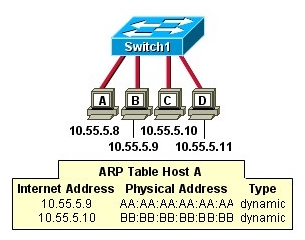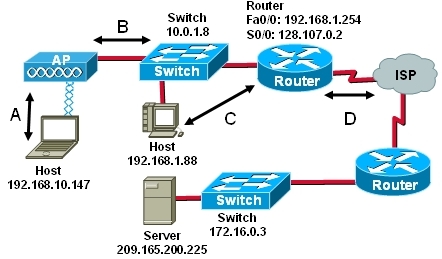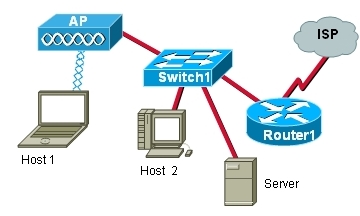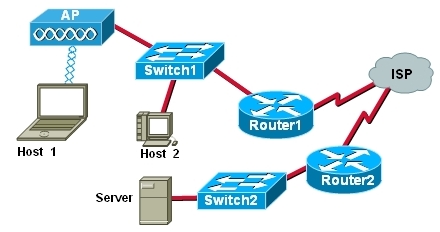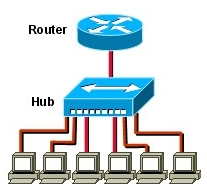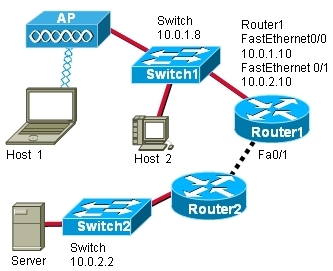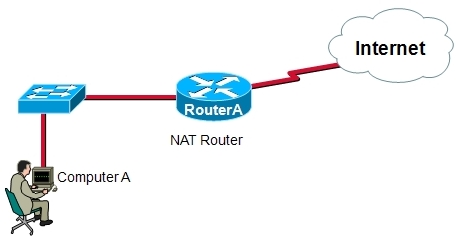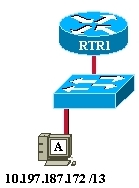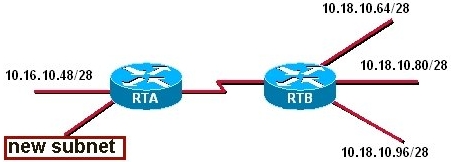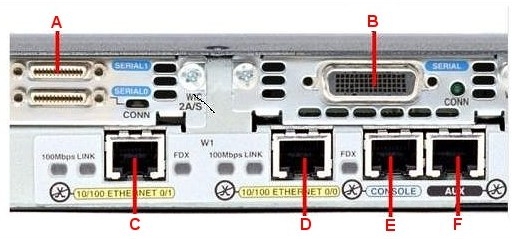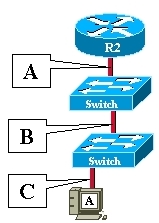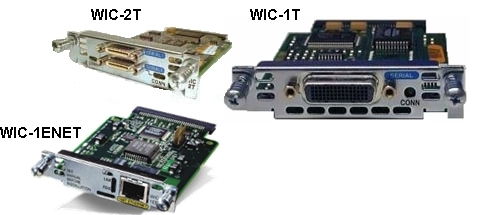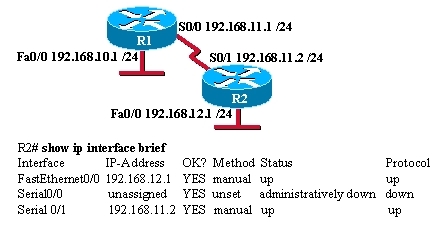A Practice Quiz For The CCENT Certification Exam
(189).jpg)
Do you have any experience with CCENT? The CCENT is the acronym for Cisco Certified Entry Networking Technician. It is an entry-level certification designed to give someone the basic knowledge to begin a career in networking and instill in someone the appropriate networking skills to understand how networking affects applications or operating systems. A programmer, for example, might be interested in this certification. This quiz will give you some insight regarding going in for this certification yourself.
- 1.
Data is being sent from a source PC to a destination server. Which three statements correctly describe the function of TCP or UDP in this situation? (Choose three.)
- A.
The UDP destination port number identifies the application or service on the server which will handle the data.
- B.
TCP is the preferred protocol when a function requires lower network overhead.
- C.
UDP segments are encapsulated within IP packets for transport across the network.
- D.
The source port field identifies the running application or service that will handle data returning to the PC.
- E.
The TCP source port number identifies the sending host on the network.
Correct Answer(s)
A. The UDP destination port number identifies the application or service on the server which will handle the data.
C. UDP segments are encapsulated within IP packets for transport across the network.
D. The source port field identifies the running application or service that will handle data returning to the PC.Explanation
The UDP destination port number identifies the application or service on the server which will handle the data. This is because the destination port number is used by the server to determine which application or service should receive the data.
UDP segments are encapsulated within IP packets for transport across the network. This is because UDP does not have its own mechanism for addressing and routing, so it relies on IP packets to transport its segments across the network.
The source port field identifies the running application or service that will handle data returning to the PC. This is because the source port number is used by the server to determine which application or service on the PC should receive the returning data.Rate this question:
-
- 2.
In what two situations would UDP be the preferred transport protocol over TCP? (Choose two.)
- A.
When applications need to guarantee that a packet arrives intact, in sequence, and unduplicated
- B.
When a faster delivery mechanism is needed
- C.
When delivery overhead is not an issue
- D.
When applications do not need to guarantee delivery of the data
- E.
When destination port numbers are dynamic
Correct Answer(s)
B. When a faster delivery mechanism is needed
D. When applications do not need to guarantee delivery of the dataExplanation
UDP would be the preferred transport protocol over TCP when a faster delivery mechanism is needed because UDP does not have the overhead of establishing and maintaining a connection like TCP does. Additionally, when applications do not need to guarantee delivery of the data, UDP can be used as it does not provide reliability mechanisms such as acknowledgments and retransmissions.Rate this question:
-
- 3.
Refer to the exhibit. Workstation A sends an IP packet to workstation B. Which two statements describe the encapsulation of the packet as it passes through the network?
- A.
The Layer 2 header is stripped from the packet by each router.
- B.
The destination Layer 2 address of the packet does not change.
- C.
The source Layer 3 address of the packet changes at each router.
- D.
The Layer 2 header changes at each router.
- E.
The Layer 3 header is stripped from the packet by each router.
Correct Answer(s)
A. The Layer 2 header is stripped from the packet by each router.
D. The Layer 2 header changes at each router.Explanation
As the IP packet passes through each router, the Layer 2 header is stripped from the packet. This means that the Layer 2 header, which contains information such as the source and destination MAC addresses, is removed by each router. Additionally, the Layer 2 header changes at each router, indicating that a new Layer 2 header is added by each router as the packet is forwarded along the network. Therefore, the correct answers are "The Layer 2 header is stripped from the packet by each router" and "The Layer 2 header changes at each router."Rate this question:
-
- 4.
Refer to the exhibit. A switch with a default configuration connects four hosts. The ARP table for host A is shown. What happens when host A wants to send an IP packet to host D?
- A.
Host A sends an ARP request to the MAC address of host D.
- B.
Host D sends an ARP request to host A.
- C.
Host A sends out the packet to the switch. The switch sends the packet only to the host D, which in turn responds.
- D.
Host A sends out a broadcast of FF:FF:FF:FF:FF:FF. Every other host connected to the switch receives the broadcast and host D responds with its MAC address.
Correct Answer
D. Host A sends out a broadcast of FF:FF:FF:FF:FF:FF. Every other host connected to the switch receives the broadcast and host D responds with its MAC address.Explanation
When host A wants to send an IP packet to host D, it sends out a broadcast of FF:FF:FF:FF:FF:FF. This broadcast is received by every other host connected to the switch. Host D, upon receiving the broadcast, responds with its MAC address. This allows host A to know the MAC address of host D, which is necessary for sending the IP packet.Rate this question:
-
- 5.
What three services are provided by the transport layer? (Choose three.)
- A.
Flow control
- B.
Encryption of data
- C.
Path determination
- D.
Connection establishment
- E.
Error recovery
Correct Answer(s)
A. Flow control
D. Connection establishment
E. Error recoveryExplanation
The transport layer provides three services: flow control, connection establishment, and error recovery. Flow control ensures that data is transmitted at an appropriate rate, preventing overwhelming the receiving device. Connection establishment establishes a reliable connection between the sender and receiver before data transfer begins. Error recovery detects and corrects errors that may occur during transmission, ensuring data integrity.Rate this question:
-
- 6.
Which layer of the OSI model handles the process of identifying and discarding damaged frames?
- A.
Presentation
- B.
Session
- C.
Transport
- D.
Network
- E.
Data link
Correct Answer
E. Data linkExplanation
The data link layer of the OSI model handles the process of identifying and discarding damaged frames. This layer is responsible for ensuring reliable transmission of data over a physical link by providing error detection and correction mechanisms. It checks the integrity of each frame received and discards any frames that are found to be damaged or corrupted.Rate this question:
-
- 7.
Refer to the exhibit. Considering the information that follows and the exhibit, where is the data flowing? Source IP address: 192.168.1.88 Destination IP address: 209.165.200.225Source MAC address: 00-11-12-7a-41-10Destination MAC address: 00-0d-cc-f4-ad-2cSource Port: 1464Destination Port: 23
- A.
A – from laptop to access point
- B.
B – from access point to attached switch
- C.
C – from host to default gateway router
- D.
D – from router to ISP
Correct Answer
C. C – from host to default gateway routerExplanation
The data is flowing from the host (laptop) to the default gateway router. This can be determined by looking at the source and destination IP addresses. The source IP address is 192.168.1.88, which is the IP address of the host (laptop), and the destination IP address is 209.165.200.225, which is the IP address of the default gateway router.Rate this question:
-
- 8.
Refer to the exhibit. If Host 1 needs to request its IP address from the server, what protocol would be used to process that request?
- A.
CSMA/CD
- B.
CSMA/CA
- C.
DHCP
- D.
ICMP
- E.
FTP
Correct Answer
C. DHCPExplanation
When Host 1 needs to request its IP address from the server, it would use the DHCP (Dynamic Host Configuration Protocol) protocol to process that request. DHCP is responsible for dynamically assigning IP addresses to devices on a network. It allows Host 1 to automatically obtain an IP address, subnet mask, default gateway, and other network configuration parameters from the server, making network configuration easier and more efficient.Rate this question:
-
- 9.
Refer to the exhibit. If Host 1 were to transfer a file to the server, what layers of the TCP/IP model would be used?
- A.
Only application and Internet layers
- B.
Only Internet and network access layers
- C.
Only application, Internet, and network access layers
- D.
Application, transport, Internet, and network access layers
- E.
Only application, transport, network, data link, and physical layers
Correct Answer
D. Application, transport, Internet, and network access layersExplanation
The correct answer is application, transport, Internet, and network access layers. This is because when Host 1 transfers a file to the server, the application layer is responsible for initiating the file transfer. The transport layer ensures reliable delivery of data by segmenting the file into smaller packets and providing error checking. The Internet layer handles the addressing and routing of the packets across the network. Finally, the network access layer is responsible for transmitting the packets over the physical network.Rate this question:
-
- 10.
ABC company needs to connect its router to an ISP to access the Internet. What device is needed to connect the router to the ISP if the ISP supplies a T1 leased line for the connection?
- A.
CSU/DSU
- B.
Modem
- C.
DSL router
- D.
NT1 device
- E.
ISDN modem
Correct Answer
A. CSU/DSUExplanation
To connect the router to the ISP using a T1 leased line, a CSU/DSU device is needed. A CSU/DSU (Channel Service Unit/Data Service Unit) is a device that converts the digital signals from the router into a format suitable for transmission over the T1 leased line. It also performs functions such as signal conditioning, line monitoring, and error detection. This device is specifically designed for connecting routers to digital leased lines like T1 lines. A modem, DSL router, NT1 device, or ISDN modem would not be suitable for this type of connection.Rate this question:
-
- 11.
Refer to the exhibit. How many collision domains exist in the exhibited network?
- A.
1
- B.
2
- C.
3
- D.
6
- E.
7
Correct Answer
A. 1Explanation
In the exhibited network, there is only one collision domain. A collision domain is a network segment where collisions can occur between devices that are connected to a shared medium, such as a hub. In this case, there is only one hub shown in the exhibit, which means that all devices connected to the hub are in the same collision domain.Rate this question:
-
- 12.
What are two actions performed by a Cisco switch? (Choose two.)
- A.
Building a routing table that is based on the first IP address in the frame header
- B.
Using the source MAC addresses of frames to build and maintain a MAC address table
- C.
Forwarding frames with unknown destination IP addresses to the default gateway
- D.
Utilizing the MAC address table to forward frames via the destination MAC address
- E.
Examining the destination MAC address to add new entries to the MAC address table
Correct Answer(s)
B. Using the source MAC addresses of frames to build and maintain a MAC address table
D. Utilizing the MAC address table to forward frames via the destination MAC addressExplanation
The two actions performed by a Cisco switch are using the source MAC addresses of frames to build and maintain a MAC address table and utilizing the MAC address table to forward frames via the destination MAC address. The switch learns the MAC addresses of devices connected to its ports by examining the source MAC address of incoming frames and then adds these entries to its MAC address table. When a frame is received, the switch looks up the destination MAC address in its table and forwards the frame to the appropriate port.Rate this question:
-
- 13.
A network administrator wants to configure a Cisco 2960 switch so that access to each switch port is limited to one MAC address. What will accomplish the administrator’s objective?
- A.
Cisco Discovery Protocol
- B.
Port security
- C.
Internet Control Message Protocol
- D.
Access lists
- E.
Flow control
Correct Answer
B. Port securityExplanation
Port security is a feature on Cisco switches that allows the network administrator to limit the number of MAC addresses that can be learned on a specific switch port. By enabling port security, the administrator can ensure that only one MAC address is allowed on each switch port, effectively limiting access to that port. This helps to prevent unauthorized devices from connecting to the network and enhances network security.Rate this question:
-
- 14.
When would you want to use the switchport port-security mac-address sticky command?
- A.
Whenever you need to protect an unused switch port
- B.
Whenever you want the port to only allow a single host device to connect
- C.
Whenever you need the port to recognize the statically assigned MAC address in the MAC address table
- D.
Whenever multiple devices share the same port
Correct Answer
D. Whenever multiple devices share the same portExplanation
The switchport port-security mac-address sticky command is used whenever multiple devices share the same port. This command enables the switch to dynamically learn the MAC addresses of the devices connected to the port and then restricts the port to only allow those specific MAC addresses. This helps in preventing unauthorized devices from connecting to the network through that port and enhances network security.Rate this question:
-
- 15.
Refer to the exhibit. Switch1 has only the following commands added to a default Cisco 2960 configuration: enable secret cisco line vty 0 4 password Kn0ckkn-cK login interface vlan 1 ip address 10.0.1.8 255.255.255.0 no shutdown Assume that routing between networks is functioning properly and that Switch2 has been properly configured for remote access. What would the result be if the telnet 10.0.2.2 command is issued from Switch1 privileged mode?
- A.
The following prompt would appear: User Access Verification Password:
- B.
Switch2 would return a destination unreachable message to Switch1.
- C.
Router1 would return a destination unreachable message to Switch1.
- D.
The packet would be dropped.
Correct Answer
D. The packet would be dropped.Explanation
When the command "telnet 10.0.2.2" is issued from Switch1 privileged mode, the packet would be dropped. This is because Switch1 has not been configured with the necessary commands to establish a telnet session with Switch2. Without the proper configuration, Switch1 is unable to establish a connection with Switch2 and the packet is dropped.Rate this question:
-
- 16.
When configuring a switch to use SSH for virtual terminal connections, what is the purpose of the crypto key generate rsa command?
- A.
Show SSH connected hosts
- B.
Disconnect SSH connected hosts
- C.
Create a public and private key pair
- D.
Show active SSH ports on the switch
- E.
Access the SSH database configuration
Correct Answer
C. Create a public and private key pairExplanation
The purpose of the "crypto key generate rsa" command is to create a public and private key pair. This key pair is necessary for secure communication between the switch and clients using SSH. The public key is used to encrypt data sent from the switch, while the private key is used to decrypt the data on the receiving end. This ensures that the communication is secure and cannot be easily intercepted or tampered with.Rate this question:
-
- 17.
Which three statements are true about full-duplex operation on an Ethernet network? (Choose three.)
- A.
There are no collisions in full-duplex mode.
- B.
A dedicated switch port is required for each node.
- C.
Hub ports are preconfigured for full-duplex mode.
- D.
The host network card must detect the availability of the media before transmitting.
- E.
The host network card and the switch port must both be in full-duplex mode.
Correct Answer(s)
A. There are no collisions in full-duplex mode.
B. A dedicated switch port is required for each node.
E. The host network card and the switch port must both be in full-duplex mode.Explanation
In full-duplex mode on an Ethernet network, there are no collisions because data can be transmitted and received simultaneously on the same link. A dedicated switch port is required for each node to enable full-duplex communication. Both the host network card and the switch port must be in full-duplex mode to ensure proper communication.Rate this question:
-
- 18.
What are three characteristics of CSMA/CD? (Choose three.)
- A.
Devices can be configured with a higher transmission priority.
- B.
A jam signal indicates that the collision has cleared and the media is not busy.
- C.
A device listens and waits until the media is not busy before transmitting.
- D.
All of the devices on a segment see data that passes on the network medium.
- E.
After detecting a collision, hosts can attempt to resume transmission after a random time delay has expired.
Correct Answer(s)
C. A device listens and waits until the media is not busy before transmitting.
D. All of the devices on a segment see data that passes on the network medium.
E. After detecting a collision, hosts can attempt to resume transmission after a random time delay has expired.Explanation
CSMA/CD (Carrier Sense Multiple Access with Collision Detection) is a protocol used in Ethernet networks. The three characteristics of CSMA/CD mentioned in the answer are:
1. A device listens and waits until the media is not busy before transmitting. This means that devices check if the network medium is idle before sending data to avoid collisions.
2. All of the devices on a segment see data that passes on the network medium. This implies that all devices on a shared network segment can see the data being transmitted by other devices.
3. After detecting a collision, hosts can attempt to resume transmission after a random time delay has expired. This feature allows devices to wait for a random period of time after a collision before retransmitting, reducing the chances of another collision occurring.Rate this question:
-
- 19.
Reference place holder.. Choose Answer C...
- A.
A
- B.
B
- C.
C
- D.
D
- E.
E
Correct Answer
C. C -
- 20.
Which three addresses are valid public addresses? (Choose three.)
- A.
198.133.219.17
- B.
192.168.1.245
- C.
10.15.250.5
- D.
128.107.12.117
- E.
64.104.78.227
Correct Answer(s)
A. 198.133.219.17
D. 128.107.12.117
E. 64.104.78.227Explanation
The three valid public addresses are 198.133.219.17, 128.107.12.117, and 64.104.78.227. These addresses are considered valid public addresses because they fall within the range of IP addresses that are designated for public use. Public IP addresses are routable on the internet and can be accessed by devices outside of a private network. In contrast, the addresses 192.168.1.245 and 10.15.250.5 are private addresses, which are reserved for use within a local network and cannot be directly accessed from the internet.Rate this question:
-
- 21.
Refer to the exhibit. Four hosts are being added to the 172.16.112.0 network. Which IP address is invalid as a host address for this network?
- A.
172.16.113.55
- B.
172.16.112.255
- C.
172.16.127.255
- D.
172.16.112.89
- E.
172.16.120.96
Correct Answer
C. 172.16.127.255Explanation
The given network address is 172.16.112.0, which means the valid host addresses for this network range from 172.16.112.1 to 172.16.127.254. Therefore, the IP address 172.16.127.255 is invalid as a host address because it is the broadcast address for this network.Rate this question:
-
- 22.
Refer to the exhibit. Using PAT, RouterA is configured to translate all private inside addresses to a single public address. The network administrator wants to determine which port number is being used in the translation of the ComputerA inside private IP address. Which command could be used if the administrator sits at ComputerA but is not allowed remote access to RouterA?
- A.
Ipconfig /all
- B.
Traceroute
- C.
Netstat
- D.
Tracert
Correct Answer
C. NetstatExplanation
The netstat command can be used to display active network connections and listening ports on a computer. By running netstat on ComputerA, the network administrator can see the port number that is being used in the translation of the inside private IP address. This information can help identify the specific translation rule being used by RouterA for ComputerA's traffic.Rate this question:
-
- 23.
What type of address is 172.16.134.64 with the subnet mask 255.255.255.224?
- A.
This is a usable host address.
- B.
This is a broadcast address.
- C.
This is a network address.
- D.
This is an Internet-routable address.
Correct Answer
C. This is a network address.Explanation
The given IP address 172.16.134.64 belongs to the network address range of the subnet with the subnet mask 255.255.255.224. The network address is the first address in the subnet range, which is used to identify the network itself. Therefore, 172.16.134.64 is the network address for this subnet.Rate this question:
-
- 24.
The router reads each bit to determine the class of an address. Which three series of binary numbers would the router identify as public Class C addresses? (Choose three.)
- A.
10101100.00100000.00010001.00010111
- B.
11000110.10000101.11011011.01010111
- C.
11010001.10100101.11001000.11101101
- D.
11000000.10101000.00100000.01000000
- E.
11000000.00011111.00000111.10111011
Correct Answer(s)
B. 11000110.10000101.11011011.01010111
C. 11010001.10100101.11001000.11101101
E. 11000000.00011111.00000111.10111011Explanation
The router identifies Class C addresses by looking at the first three bits of the first octet. If the first three bits are 110, it is a Class C address. The three binary numbers that start with 110 are: 11000110.10000101.11011011.01010111, 11010001.10100101.11001000.11101101, and 11000000.00011111.00000111.10111011. These are the three public Class C addresses.Rate this question:
-
- 25.
Given a host with the IP address 192.168.65.54 and a subnet mask of 255.255.255.240, to which network does the host belong?
- A.
192.168.65.16
- B.
192.168.65.32
- C.
192.168.65.48
- D.
192.168.65.64
Correct Answer
C. 192.168.65.48Explanation
The given host belongs to the network 192.168.65.48 because the subnet mask 255.255.255.240 indicates that the first 28 bits of the IP address are used for the network address, and the remaining 4 bits are used for host addresses. So, the network address is obtained by applying the subnet mask to the IP address, which gives 192.168.65.48 as the network address.Rate this question:
-
- 26.
Refer to the exhibit. Which IP address can be assigned to the default gateway for host A?
- A.
10.184.0.1
- B.
10.192.0.0
- C.
10.199.255.254
- D.
10.200.255.254
Correct Answer
C. 10.199.255.254Explanation
The IP address 10.199.255.254 can be assigned to the default gateway for host A because it falls within the same network range as the IP address of host A (10.199.0.0/16). The default gateway is typically the IP address of the router that connects the local network to external networks.Rate this question:
-
- 27.
Refer to the exhibit. What would be a valid network address for the new subnet on RTA?
- A.
10.16.10.16/28
- B.
10.16.10.24/28
- C.
10.16.10.30/28
- D.
10.16.10.56/28
- E.
10.16.10.72/28
Correct Answer
A. 10.16.10.16/28Explanation
The given subnet mask is /28, which means that the first 28 bits of the IP address represent the network address. In the given options, 10.16.10.16 is the only IP address where the first 28 bits match with the given IP address 10.16.10.16/28. Therefore, 10.16.10.16 is the valid network address for the new subnet on RTA.Rate this question:
-
- 28.
Refer to the exhibit. The network shown is using classful subnetting. The serial link between routers A and B is configured with addresses from the 172.16.6.0/23 subnet. How many valid IP addresses are wasted on this subnetwork?
- A.
252
- B.
254
- C.
256
- D.
508
- E.
510
Correct Answer
D. 508Explanation
In classful subnetting, a /23 subnet has a subnet mask of 255.255.254.0. This means that the network can have a total of 512 IP addresses. However, the question states that the serial link between routers A and B is configured with addresses from the 172.16.6.0/23 subnet. This means that the network can only use 510 IP addresses because the first and last IP addresses in the subnet are reserved for the network address and the broadcast address, respectively. Therefore, 508 valid IP addresses are wasted on this subnetwork.Rate this question:
-
- 29.
What are three valid host addresses given a subnet mask of 255.255.254.0? (Choose three.)
- A.
64.100.2.255
- B.
172.55.33.255
- C.
64.104.129.0
- D.
192.168.162.255
- E.
10.165.55.255
Correct Answer(s)
A. 64.100.2.255
C. 64.104.129.0
D. 192.168.162.255Explanation
The given subnet mask 255.255.254.0 allows for a total of 9 bits for host addresses. This means that the last 9 bits of the IP address can be used for host addresses.
Among the given options, 64.100.2.255, 64.104.129.0, and 192.168.162.255 have the last 9 bits as 111111111, which are valid host addresses within the given subnet mask.Rate this question:
-
- 30.
Refer to the exhibit. Which two interfaces could be used for a leased-line WAN connection? (Choose two.)
- A.
A
- B.
B
- C.
C
- D.
D
- E.
E & F
Correct Answer(s)
A. A
B. BExplanation
The correct answer is A and B. The exhibit does not provide any specific information about the interfaces or the devices. However, in a leased-line WAN connection, commonly used interfaces are T1/E1 and Serial interfaces. Therefore, it can be inferred that interfaces A and B could be used for a leased-line WAN connection.Rate this question:
-
- 31.
What type of cable is used for connectivity between a model 2620 router and a model 2950 switch (point A), a model 2950 switch and a model 1900 switch (point B), and a model 2950 switch and a host (point C)?
- A.
A – straight-through; B – rollover; C – straight-through
- B.
A – crossover; B – straight-through; C – straight-through
- C.
A – straight-through; B – straight-through; C – crossover
- D.
A – crossover; B – straight-through; C – crossover
- E.
A – straight-through; B – crossover; C – straight-through
Correct Answer
E. A – straight-through; B – crossover; C – straight-throughExplanation
The correct answer is A – straight-through; B – crossover; C – straight-through.
In this scenario, a straight-through cable is used for connectivity between the model 2620 router and the model 2950 switch at point A. This is because both devices are of different types (router and switch), and a straight-through cable is used to connect different types of devices.
At point B, a crossover cable is used to connect the model 2950 switch and the model 1900 switch. This is because both devices are of the same type (switch), and a crossover cable is used to connect devices of the same type.
Finally, at point C, another straight-through cable is used to connect the model 2950 switch and the host. This is because the host is a different type of device (computer or server), and a straight-through cable is used to connect different types of devices.Rate this question:
-
- 32.
Refer to the exhibit. A small business has asked for advice about what type of cable will be needed to connect their modular routers. What type of connector is used by each device that is shown?
- A.
WIC-2T is a DB60 connector, WIC1T is a Smart Serial connector, and WIC-1ENET is an RJ45 connector.
- B.
WIC-2T is an RJ45 connector, WIC1T is a DB60 connector, and WIC-1ENET is a Smart Serial connector.
- C.
WIC-2T is a DB60 connector, WIC1T is a Smart Serial connector, and WIC-1ENET is an RJ45 connector.
- D.
WIC-2T is a Token Ring connector, WIC1T is a DB25 connector, and WIC-1ENET is an RJ11 connector.
- E.
WIC-2T is a Smart Serial connector, WIC1T is a DB60 connector, and WIC-1ENET is an RJ45 connector.
Correct Answer
E. WIC-2T is a Smart Serial connector, WIC1T is a DB60 connector, and WIC-1ENET is an RJ45 connector.Explanation
The correct answer is that the WIC-2T uses a Smart Serial connector, the WIC1T uses a DB60 connector, and the WIC-1ENET uses an RJ45 connector. This can be determined by examining the exhibit and identifying the connectors on each device. The WIC-2T device has a small, compact connector which is characteristic of a Smart Serial connector. The WIC1T device has a larger, circular connector which is characteristic of a DB60 connector. The WIC-1ENET device has a rectangular connector with eight pins, which is characteristic of an RJ45 connector.Rate this question:
-
- 33.
Refer to the exhibit. The router that is named myhome has received a frame from the host 192.168.254.7. The contents of this frame are being sent to host 172.16.14.243. What is the Layer 2 destination address of the frame as it leaves the myhome router?
- A.
0008.a3b6.ce05
- B.
0009.1281.18a8
- C.
000a.8a47.e612
- D.
172.16.14.129
- E.
172.16.14.243
Correct Answer
A. 0008.a3b6.ce05Explanation
The Layer 2 destination address of the frame as it leaves the myhome router is 0008.a3b6.ce05.Rate this question:
-
- 34.
Why is it important for the router to maintain an accurate routing table?
- A.
To provide Layer 2 addressing information for the next hop
- B.
To prevent broadcasts from occurring on the LAN
- C.
To determine the best path to the destination network
- D.
To identify all of the routers in a network
Correct Answer
C. To determine the best path to the destination networkExplanation
It is important for the router to maintain an accurate routing table because it allows the router to determine the best path to the destination network. The routing table contains information about the available paths and their associated metrics, such as hop count, bandwidth, and delay. By accurately maintaining this table, the router can make informed decisions on which path to choose in order to efficiently deliver packets to their intended destination. This helps to optimize network performance and ensure that data is transmitted in the most efficient and reliable manner.Rate this question:
-
- 35.
Refer to the exhibit. Based on the exhibited router output, what two conclusions can be made? (Choose two.)
- A.
The enable password has been encrypted.
- B.
The service password-encryption command has not been added to the configuration.
- C.
The passwords that are shown restrict access to the router console.
- D.
The password that will gain access to privileged mode is sys#op.
- E.
The passwords that are shown will be required to enter privileged EXEC mode on this router.
Correct Answer(s)
B. The service password-encryption command has not been added to the configuration.
E. The passwords that are shown will be required to enter privileged EXEC mode on this router.Explanation
Based on the exhibited router output, two conclusions can be made. First, the service password-encryption command has not been added to the configuration, as the enable password is shown in clear text. Second, the passwords that are shown will be required to enter privileged EXEC mode on this router, as the output indicates that the enable password is required for privileged mode access.Rate this question:
-
- 36.
What would be a common reason to upgrade from RIPv1 to RIPv2?
- A.
RIPv2 takes less router memory than RIPv1 takes.
- B.
RIPv2 supports a larger network (more routers) than RIPv1 supports.
- C.
RIPv2 supports discontiguous networks and RIPv1 does not.
- D.
RIPv2 supports classless routing. RIPv1 is classful.
Correct Answer
D. RIPv2 supports classless routing. RIPv1 is classful.Explanation
RIPv2 supports classless routing, which means it can advertise subnets with variable length subnet masks (VLSM). This allows for more efficient use of IP addresses and better scalability compared to RIPv1, which only supports classful routing. Therefore, upgrading from RIPv1 to RIPv2 would be a common reason to take advantage of the benefits of classless routing.Rate this question:
-
- 37.
- A.
The protocol that communicated this information operates at Layer 3 of the OSI model.
- B.
The output of this command displays information about directly connected Cisco devices only.
- C.
The switch is attached to the SanJose1 FastEthernet0/21 interface.
- D.
SanJose1 is running CDP version 12.0.
- E.
SanJose2 is a 2600 series router running several routed protocols.
Correct Answer(s)
B. The output of this command displays information about directly connected Cisco devices only.
E. SanJose2 is a 2600 series router running several routed protocols. -
- 38.
Which two statements describe the command ip route 192.168.7.24 255.255.255.248 192.168.7.9? (Choose two.)
- A.
A packet that is destined for host 192.168.7.30 will be forwarded to address 192.168.7.9.
- B.
The address 192.168.7.9 is the destination network for this route.
- C.
The address 192.168.7.24 is the next-hop router in this command.
- D.
This command is issued from the interface configuration mode.
- E.
This command is used to define a static route.
Correct Answer(s)
A. A packet that is destined for host 192.168.7.30 will be forwarded to address 192.168.7.9.
E. This command is used to define a static route.Explanation
The command "ip route 192.168.7.24 255.255.255.248 192.168.7.9" is used to define a static route. It specifies that any packet destined for host 192.168.7.30 should be forwarded to the next-hop router with the address 192.168.7.9. Therefore, the statement "A packet that is destined for host 192.168.7.30 will be forwarded to address 192.168.7.9" is correct.Rate this question:
-
- 39.
Which group of commands allows a router to be administered remotely?
- A.
Line con 0 password class login
- B.
Interface fa0/1 ip address 192.168.10.1 255.255.255.0 access-class 1 in
- C.
Line vty 0 4 password cisco login
- D.
Interface vlan 1 ip address 192.168.10.1 255.255.255.0 no shutdown
Correct Answer
C. Line vty 0 4 password cisco loginExplanation
The group of commands "line vty 0 4, password cisco, login" allows a router to be administered remotely. The "line vty 0 4" command specifies the virtual terminal lines that can be used for remote administration. The "password cisco" command sets the password for remote access. The "login" command enables the router to prompt for a password when someone tries to connect remotely.Rate this question:
-
- 40.
Which protocol is described as an enhanced distance vector routing protocol?
- A.
RIP v1
- B.
RIP v2
- C.
EIGRP
- D.
OSPF
Correct Answer
C. EIGRPExplanation
EIGRP (Enhanced Interior Gateway Routing Protocol) is described as an enhanced distance vector routing protocol. It combines the features of both distance vector and link-state routing protocols, providing fast convergence, loop prevention mechanisms, and efficient use of bandwidth. EIGRP uses a metric based on bandwidth, delay, reliability, and load to determine the best path for routing.Rate this question:
-
- 41.
Why is the ip host command used to create host tables on Cisco routers?
- A.
To create static routes to specific hosts
- B.
To allow communication with other IP devices by name
- C.
To provide a meaningful name for the local router
- D.
To identify only the directly attached networks and associated hosts
- E.
To define the host devices with which the router is allowed to connect
Correct Answer
B. To allow communication with other IP devices by nameExplanation
The ip host command is used to create host tables on Cisco routers in order to allow communication with other IP devices by name. This means that instead of using IP addresses to communicate with devices, the router can use the names assigned to those devices in the host table. This makes it easier for administrators to manage and identify devices on the network, as they can use familiar names instead of memorizing or looking up IP addresses.Rate this question:
-
- 42.
Refer to the exhibit. From router R1, the command telnet 192.168.11.2 is entered from privileged mode and this message displays: 00:06:45: %SYS-5-CONFIG_I: Configured from console by console 192.168.11.2Trying 192.168.11.2 . . . Open Password required, but none set If the R2 interfaces are in the status shown in the exhibit, what is the most likely problem?
- A.
The enable secret command is missing from R2.
- B.
The enable password command is missing from R1.
- C.
The login command is missing from the line configuration mode on R2.
- D.
The password command is missing from the line configuration mode on R2.
- E.
The no shutdown command is missing from the Serial 0/0 interface mode on R1.
Correct Answer
D. The password command is missing from the line configuration mode on R2.Explanation
The message "Password required, but none set" indicates that a password is required to access the device, but no password has been set. This suggests that the problem lies with the configuration on R2, specifically in the line configuration mode. The password command is used to set a password for accessing the device, so if it is missing from the line configuration mode on R2, it would explain why the telnet command from R1 is prompting for a password that has not been set.Rate this question:
-
- 43.
Which two items can be modified by the system administrator to determine from where the Cisco IOS loads? (Choose two.)
- A.
System ROM
- B.
Startup configuration file
- C.
System image file
- D.
Configuration register value
- E.
Bootloader image file
Correct Answer(s)
B. Startup configuration file
D. Configuration register valueExplanation
The system administrator can modify the startup configuration file and the configuration register value to determine from where the Cisco IOS loads. The startup configuration file contains the configuration settings for the device and can be modified to specify the source from which the IOS should load. The configuration register value is a 16-bit value that determines various settings for the device, including the source from which the IOS should load. By modifying these two items, the system administrator can control the boot process and specify the desired source for loading the IOS.Rate this question:
-
- 44.
What are two requirements for establishing a console communication session between a computer and a router? (Choose two.)
- A.
A console cable must be used from the console port of the router to the NIC of the computer.
- B.
A rollover cable must be used from the console port of the router to the serial port of the computer.
- C.
A default gateway must be configured on the computer.
- D.
The IP addresses assigned to the router and computer must be on the same subnetwork.
- E.
There must be a terminal emulator application on the computer.
Correct Answer(s)
B. A rollover cable must be used from the console port of the router to the serial port of the computer.
E. There must be a terminal emulator application on the computer.Explanation
To establish a console communication session between a computer and a router, two requirements must be met. Firstly, a rollover cable must be used to connect the console port of the router to the serial port of the computer. This cable is specifically designed for this purpose. Secondly, there must be a terminal emulator application installed on the computer. This application allows the computer to communicate with the router via the console connection. Without these two requirements, the console communication session cannot be established.Rate this question:
-
- 45.
For Reference only... Choose C....
- A.
A
- B.
B
- C.
C
- D.
D
- E.
E
Correct Answer
C. C -
- 46.
What is the outcome when a wireless host has a different SSID configured than the access point to which it is attempting to connect?
- A.
The access point will send the host a rejection message.
- B.
The host will be prompted for a userid and password.
- C.
The access point will send the host a challenge message.
- D.
The host will only be allowed access to the Internet.
- E.
The host will not be allowed access to the wireless network.
Correct Answer
E. The host will not be allowed access to the wireless network.Explanation
When a wireless host has a different SSID configured than the access point it is trying to connect to, it will not be allowed access to the wireless network. The SSID (Service Set Identifier) is a unique identifier that distinguishes one wireless network from another. If the host's SSID does not match the access point's SSID, the access point will not grant access to the host, preventing it from connecting to the wireless network.Rate this question:
-
- 47.
A wireless network has one access point installed. Users at some locations in the office complain that their wireless access is slow, while others say that the wireless network performance is fine. What should be done to remedy this situation?
- A.
Replace the access point.
- B.
Install another access point at another location within the office.
- C.
Upgrade the wireless NICs in the hosts that are slow.
- D.
Limit the number of wireless hosts that attach to the access point at one time.
- E.
Convert back to a wired network.
Correct Answer
B. Install another access point at another location within the office.Explanation
To improve the wireless network performance in the office, installing another access point at a different location within the office is recommended. This will help to distribute the network coverage more evenly and reduce congestion. By adding another access point, users in the areas that are currently experiencing slow access will have better connectivity and improved network performance.Rate this question:
-
- 48.
Which technology is primarily used for security in a wireless network environment?
- A.
SSH
- B.
WPA
- C.
SSID
- D.
CSMA/CA
- E.
CSMA/CD
Correct Answer
B. WPAExplanation
WPA (Wi-Fi Protected Access) is primarily used for security in a wireless network environment. It is a security protocol designed to provide secure access to Wi-Fi networks. WPA encrypts the data transmitted over the network, making it difficult for unauthorized users to access and intercept the information. It uses authentication and encryption methods to ensure the confidentiality and integrity of the data being transmitted. WPA also supports different authentication methods, such as Pre-Shared Key (PSK) and Enterprise, providing flexibility in securing wireless networks.Rate this question:
-
- 49.
For Reference only... Choose D....
- A.
A
- B.
B
- C.
C
- D.
D
- E.
E
Correct Answer
D. D -
- 50.
Which technology is primarily used in a WAN?
- A.
ARP
- B.
CDP
- C.
PPP
- D.
WEP
- E.
CSMA/CD
Correct Answer
C. PPPExplanation
PPP (Point-to-Point Protocol) is primarily used in a WAN (Wide Area Network). PPP is a data link protocol that is used to establish a direct connection between two nodes in a network. It provides a secure and reliable way to transmit data over a WAN connection. ARP (Address Resolution Protocol) is used to map an IP address to a physical MAC address in a LAN (Local Area Network). CDP (Cisco Discovery Protocol) is a proprietary protocol used by Cisco devices to share information about connected devices. WEP (Wired Equivalent Privacy) is a security protocol used in wireless networks. CSMA/CD (Carrier Sense Multiple Access with Collision Detection) is a protocol used in Ethernet networks to manage access to the network medium.Rate this question:
-
Quiz Review Timeline +
Our quizzes are rigorously reviewed, monitored and continuously updated by our expert board to maintain accuracy, relevance, and timeliness.
-
Current Version
-
Mar 22, 2023Quiz Edited by
ProProfs Editorial Team -
May 16, 2010Quiz Created by
Rodney.butler
 Back to top
Back to top




